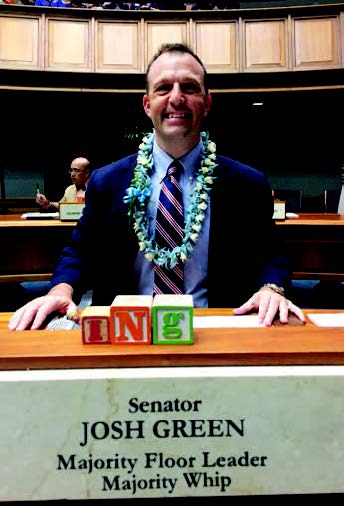

Interviewed March 2016
Story by Elaine Christianson
This is the fourth in a series of interviews of the Kohala Hospital Emergency Room Physician staff conducted by Elaine Christianson, secretary of the Kohala Hospital Charitable Foundation Board. Dr. Green serves in the Kohala Hospital Emergency Room.
Christianson: By way of background, after residency at the University of Pittsburgh Medical Center, I read you joined the National Health Service Corps and were awarded a scholarship to pay off medical school loans, on the condition that you commit to a four-year term.
Dr. Green: Yes, that’s luckily what brought me to Hawai`i. I became the sole family physician, and ER physician at Pahala Hospital, in the Ka`u district for approximately eight thousand inhabitants. Disturbed by the challenges of the methamphetamine drug problems and shortage of physicians, I decided to run for office and work at another level to improve health care. I was elected to the Hawai`i House of Representatives and now serve as Senator for District 3.
Christianson: How do you juggle your political duties and your medical duties?
Dr. Green: Sleep deprivation! I am in the Capitol during session and come up to do ER work here in Kohala on weekends. Wearing both hats keeps me connected to my medical profession and at the same time aware of what the larger health care needs are for the State. I fought for additional resources for Kona and Kohala Hospitals, and introduced bills to provide coverage for rape victims, children with autism and cleft palate, and other health related bills.
Christianson: Is it easier to save a life, or pass legislation?
Dr. Green: It’s much easier to save a life! Passing legislation requires navigating a lot of landmines and dealing with people with differing agendas and ideologies, and can take years. Saving a life, we are all working towards the same end.
Christianson: I was interested to read about Senate Bill 3064, which re-structured Hawai`i Health Systems Corporation (HHSC) – Kohala being one of their 14 Hawai`i State owned hospitals – to allow partnerships with a private entities in Hawai`i. Recent examples are Queens Medical Center with North Hawai`i Community Hospital, and Kaiser P e r m a n e n t e Medical Care Program with Maui Memorial Medical Center.
Dr. Green: Because we have a large sector of people on Medicare and Medicaid in this rural area, we will always be underfunded for our safety net system, so creating partnerships, with a strong preference for Hawai`i-based entities, is something we need to consider.
Christianson: Who are the possible partners?
Dr. Green: There are three, actually: Hawai`i Pacific Health, Kaiser Permanente, and Queens Medical Center. The highest probability is Queens. That way we could possibly have a new Kona Hospital triangulating care with Kohala and Waimea.
Christianson: I heard an interview you did with Dr. Linda Rosen, the CEO for HHSC who was responsible for creating the trauma care system statewide.
Dr. Green: Yes, we passed the tobacco tax to help fund this. Consultations with specialists over the Internet save a lot of time and expense. I’ve been pushing legislation this year to mainstream TeleHealth – using technology to send images for consultations with outside experts. This translates into giving people better care and helps solve problems of smaller populations, distance to care, and shortage of doctors. But, I can say that compared to experience in India and in my hospital work in Swaziland, Kohala Hospital is an incredible upgrade.
Technology aside, there is no substitute for face-to-face, hands on diagnostics. As my mentor said, “Look at the patient.”
Christianson: I heard an interview with you by Bob Martin at the North Kohala radio station about Dengue Fever. What comments do you have?
Dr. Green: I was concerned right from the get-go because we knew a lot of people didn’t come to get tested, and if it continued its rapid growth we would not be able to get ahead of it. To date we have not seen any cases in North Kohala and the outbreak seems to be slowing down. But because the mosquito is the same for Dengue and Zika virus, I have been pressing the Department of Health to take this seriously. We don’t have the capacity to deal with a large outbreak.
Christianson: Let’s talk briefly about money. How much did the State contribute in 2015 to subsidize the hospitals in HHSC?
Dr. Green: A hundred million dollars – about 20% of the budget – which we hope to reduce over the next decade by 10%. If we were to modernize all of the hospitals in this system, it would cost about a billion dollars. That’s why we need to look at the partnerships we’ve discussed.
Christianson: Over the course of this conversation you have reassured me that you are committed to keep Kohala Hospital open, and in fact that was the reason the Kohala Hospital Charitable Foundation was created: to raise funds and keep our hospital functioning. Clearly a billion dollars is beyond the scope of our Foundation (chuckle) but we thank you for your efforts in support our mutual goal, both as a physician and a legislator.

Photo courtesy of Josh Green
Dr. Josh Green serves as a North Kohala Hospital Emergency Room physician and Hawai`i State Senator, District 3.